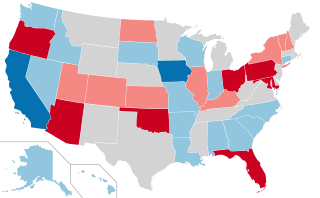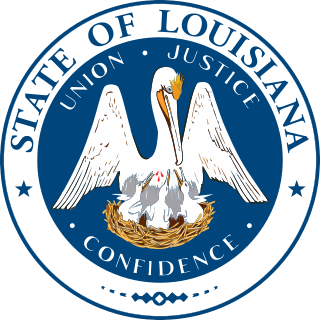
The 1976 United States Senate elections was an election for the United States Senate that coincided with Democratic Jimmy Carter's presidential election and the United States Bicentennial celebration. Although almost half of the seats decided in this election changed parties, Carter's narrow victory did not provide coattails for the Democrats, and the balance of the chamber remained the same.

The 1970 United States Senate elections was an election for the United States Senate, taking place in the middle of Richard Nixon's first term as President. The Democrats lost a net of three seats, while the Republicans and the Conservative Party of New York picked up one net seat each, and former Democrat Harry F. Byrd Jr. was re-elected as an independent.

The 1968 United States Senate elections were elections for the United States Senate which coincided with the presidential election of the same year. Although Richard Nixon won the presidential election narrowly, the Republicans picked up five net seats in the Senate. Republicans would gain another seat after the election when Alaska Republican Ted Stevens was appointed to replace Democrat Bob Bartlett.

The 1964 United States Senate elections coincided with the election of President Lyndon B. Johnson by an overwhelming majority, to a full term. His Democratic Party picked up a net two seats from the Republicans. As of 2021, this is the last time either party has had a two-thirds majority in the Senate, which would have hypothetically allowed the Senate Democrats to override a veto, propose constitutional amendments, convict and expel certain officials, or invoke cloture without any votes from Senate Republicans. In practice, however, internal divisions could have prevented the Democrats from doing so. The Senate election coincided with Democratic gains in the House in the same year.

Paul Jones Fannin was an American businessman and politician. A Republican, he served as a U.S. Senator from Arizona from 1965 to 1977. He previously served as the 11th Governor of Arizona from 1959 to 1965.
Thomas Lee Judge was an American politician, and was the 18th Governor of Montana from 1973 to 1981.

The 2016 United States Senate elections were held on November 8, 2016. The presidential election, House elections, 14 gubernatorial elections, and many state and local elections were held on the same date.

The 2014 Wyoming gubernatorial election was held on November 4, 2014, to elect the Governor of Wyoming. The election coincided with elections to other federal and state offices.

The 1964 United States Senate election in Arizona took place on November 3, 1964. Incumbent Republican U.S. Senator Barry Goldwater decided not to run for reelection to a third term, instead running for President of the United States as the Republican Party nominee against Lyndon B. Johnson. Governor of Arizona Paul Fannin ran unopposed in the Republican primary, and defeated Democratic nominee Roy Elson, who was a staff member for U.S. Senator Carl Hayden until Hayden's retirement in 1969.

A general election was held in the U.S. state of New Mexico on November 4, 2014. All of New Mexico's executive officers were up for election as well as a United States Senate seat, and all of New Mexico's three seats in the United States House of Representatives. Primary elections were held on June 3, 2014.

A general election was held in the U.S. state of Arizona on November 4, 2014. All of Arizona's executive officers were up for election as well as all of Arizona's nine seats in the United States House of Representatives. Primary elections were held on August 26, 2014.

The 2016 United States House of Representatives elections in Arizona were held on November 8, 2016, to elect the nine U.S. Representatives from the state of Arizona, one from each of the state's nine congressional districts. The elections coincided with the 2016 U.S. presidential election, as well as other elections to the House of Representatives, elections to the United States Senate and various state and local elections. The primaries were held on August 30.

A general election was held in the U.S. state of Louisiana on October 24, 2015. All of Louisiana's executive officers, and both houses of the Louisiana State Legislature were up for election. Under Louisiana's jungle primary system, all candidates appeared on the same ballot, regardless of party and voters voted for any candidate, regardless of their party affiliation. Since no candidate received a majority of the vote during the primary election, a runoff election was held on November 21, 2015 between the top two candidates in the primary. Louisiana is the only state that has a jungle primary system.

A general election was held in the U.S. state of Arizona on November 6, 2018. All of Arizona's executive offices were up for election as well as a United States Senate seat and all of Arizona's nine seats in the United States House of Representatives. The Republican Party won the majority of statewide offices, albeit by much narrower margins than in previous elections, while the Democratic Party picked up three statewide offices.

The 1962 Arizona gubernatorial election took place on November 6, 1962. Incumbent Governor Paul Fannin ran for reelection against President of the Western Conference of United Funds Samuel Pearson Goddard in the general election, winning a third consecutive term, a first for a Republican Governor in Arizona. Fannin was sworn into his third term on January 1, 1963.

The 1964 Arizona gubernatorial election took place on November 3, 1964. Incumbent Governor Paul Fannin decided not to run for reelection to a fourth term as governor, instead deciding to successfully run for the United States Senate when incumbent U.S. Senator Barry Goldwater decided to run for President of the United States.

United States gubernatorial elections will be held on November 8, 2022, in 36 states and three territories. Also, special elections may take place if other gubernatorial seats are vacated.

The 2018 Massachusetts general election was held on November 6, 2018, throughout Massachusetts. Primary elections took place on September 6. Early voting took place from October 22 through November 2.

The 2022 Arizona elections will be held in the state of Arizona on November 8, 2022 coinciding with the nationwide general election. All six executive offices are up for election, as well as a U.S. Senate seat, all of the state's U.S. House of Representatives seats, and the state legislature.

The 2018 United States Attorney General elections were held on November 6, 2018, in 30 states, 2 territories, and the District of Columbia. The previous attorney general elections for this group of states took place in 2014, except in Vermont where attorneys general serve only two-year terms and elected their current attorney general in 2016.


















